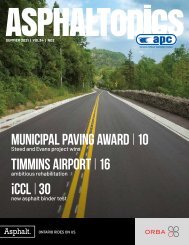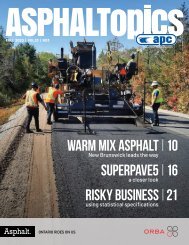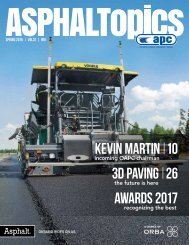ASPHALTopics | Summer 2020 | VOL 33 | NO 2
ASPHALTopics is the official publication of the Ontario Asphalt Pavement Council - A Council of the Ontario Road Builders' Association. Articles within ASPHALTopics may not be republished without express permission from OAPC.
ASPHALTopics is the official publication of the Ontario Asphalt Pavement Council - A Council of the Ontario Road Builders' Association. Articles within ASPHALTopics may not be republished without express permission from OAPC.
- No tags were found...
Create successful ePaper yourself
Turn your PDF publications into a flip-book with our unique Google optimized e-Paper software.
by Lara Henry
On April 22, the world paused in the midst of a pandemic to mark
the 50 th anniversary of Earth Day. We are all familiar with the three
Rs—reduce, reuse, recycle—as a way to minimize the effect on the
environment from materials we use every day. From a pavement
perspective, the use of RAP is a key component of the three Rs. In
addition to environmental and sustainability benefits, recycled asphalt
pavement or RAP offers economic savings and engineering benefits.
At ORBA’s 93 rd annual convention held February 2 to 4,
2020, Mark Eby, Director of Infrastructure for the
County of Brant, and Jim Musselman, Senior Engineer
at the National Centre of Asphalt Technology, spoke
about best practices for using RAP and managing
RAP stockpiles, and showcased Ontario projects that
have produced quality asphalt pavements using RAP.
A MUNICIPAL PERSPECTIVE
Municipalities collectively use the most aggregate
in the province and need to be leaders in the
stewardship of that finite aggregate resource.
In his presentation, Mark Eby explained how the
County of Wellington saw an opportunity to increase
the use of RAP in its mix designs. “As owners we
have to manage the balance between having a
quality, long-lasting pavement and the appropriate
reuse of materials.”
Through consultation with the Municipal Liaison
Hot Mix Committee, Wellington’s RAP specification
was reviewed. The county mandates that all surface
mixes have at least 10 per cent RAP and base
mixes have 20 per cent RAP. It permits RAP up to
20 per cent in surface course mixes (HL-3 and HL-4)
and 40 per cent RAP in medium duty binder mixes
(HL-4 and HL-8). The County of Brant also will be
increasing the permitted RAP percentages to meet
that of Wellington.
Eby stressed that the key to getting to the higher
RAP percentages is trust. Owners and contractors
need to work together to ensure that what is
supplied and paved is a quality product. RAP
needs to be processed to create a good, high
quality product that can be added to new hot mix.
He added that Wellington has had years of success
with contractors paving with a 20 per cent RAP base
and 10 per cent surface mix with no issues and no
early failures. In fact, Capital Paving Inc. and the
Murray Group Limited have successfully paved roads
with greater than 30 per cent in the base and up to
20 per cent in the surface.
Eby concluded by urging urban municipalities
to allow RAP to be used and in greater quantities,
and to share the resource. When aggregate is
shipped into the urban centres to make hot mix,
that opportunity should be used to haul back RAP
to the rural municipalities for inclusion in new hot
mix. Bottom line: everyone needs to work together
to make environmentally-responsible, quality
pavements that last. ››
SUMMER 2020 35


















